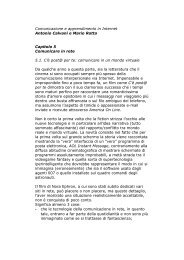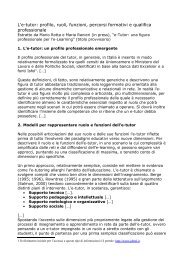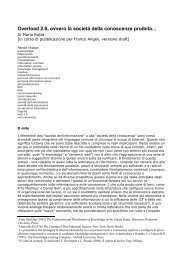Problem Based Learning e Project Based Learning
Problem Based Learning e Project Based Learning
Problem Based Learning e Project Based Learning
- No tags were found...
You also want an ePaper? Increase the reach of your titles
YUMPU automatically turns print PDFs into web optimized ePapers that Google loves.
oooooooooooooooooooooooooMurphy E. (2004), Identifying and Measuring Ill-Structured <strong>Problem</strong> Formulation and Resolutionin Online Asynchronous Discussions. http://www.cjlt.ca/content/vol30.1/cjlt30-1_art1.htmlNelson, L. M. (1999). Collaborative problem solving. In C. M. Reigeluth (Ed.), Instructional DesignTheories and Models: A New Paradigm of Instructional Theory (Vol. II) (pp.241-267). Mahwah,NJ: Lawrence Erlbaum Associates.Newman, M J. (2003) A pilot systematic review and meta-analysis on the effectiveness of<strong>Problem</strong> <strong>Based</strong> <strong>Learning</strong>, (Newcastle, Higher Education Academy Subject Centre for Medicine,Dentistry & Veterinary Medicine.). In Internet, URL:http://www.tlrp.org/dspace/retrieve/1389/pbl_report.pdf.Newman M.J., Ambrose K., Corner T., Evans J., Morris-Vincent P., QuinnS., Stephenson J. eVernon L. (2003),Evaluating educational impact: The approach followed by The <strong>Project</strong> on theEffectiveness of <strong>Problem</strong> <strong>Based</strong> <strong>Learning</strong> (PEPBL). In Internet, URL:http://www.lle.mdx.ac.uk/iclml/mnaera03.pdf.Norman, G. R., Schmidt, H. G. (1992). The Psychological Basis of <strong>Problem</strong>-<strong>Based</strong> <strong>Learning</strong>; AReview of the Evidence. Academic Medicine,67(9),557-65.Peterson M. (1997), Skills to Enhance <strong>Problem</strong>-based <strong>Learning</strong>. http://www.med-edonline.org/f0000009.htmPiccinini N. e Scollo G. (2006), Cooperative <strong>Project</strong>-based <strong>Learning</strong> in a Web-based SoftwareEngineering Course. Educational Technology & Society, 9 (4), 54-62.Polman, J. L. (2000). Designing project-based science: Connecting learners through guidedinquiry. New York: Teachers College Press.<strong>Problem</strong>-based <strong>Learning</strong>: Theory, Practice and Research, numero speciale di “Zeitschrift fürHochschuldidaktik”. http://www.oeghd.or.at/zeitschrift/1997h1/index_e.htmlRanieri M. (2005), E-<strong>Learning</strong>: modelli e strategie didattiche, Trento, EricksonRotondi M. (2000), Facilitare l’apprendere. Modi e percorsi per una formazione di qualità, Milano,Franco AngeliSavery, J. & Duffy, T. (1995). <strong>Problem</strong> based learning: an instructional model and itsconstructivist framework. In B. G. Wilson (Ed.), Designing Constructivist <strong>Learning</strong> Environments(pp. 135-148). Englewood Cliffs: Educational Technology Publications.Schank, R. C., Berman, t. R. & Macperson, K. A. (1999). <strong>Learning</strong> by doing. In C. M. Reigeluth(Ed.), Instructional Design Theories and Models: A New Paradigm of Instructional Theory (Vol. II)(pp.161-181). Mahwah, NJ: Lawrence Erlbaum Associates.Schmidt H.G. (1993). Foundations of problem-based learning: some explanatory notes. MedicalEducation 27:422-432, 1993Schwartz, P. Mennin S., Webb, G. (Eds.). (2001). <strong>Problem</strong> <strong>Based</strong>-<strong>Learning</strong>: Case Studies,Experience and Practice. Taylor & Francis Group.Spiro, R. J. & Jehng, J. C. (1990). Cognitive flexibility and hypertext: theory and technology forthe nonlinear and multidimensional traversal of complex subject matter. In D. Nix & R. Spiro(Eds.), Cognition, Education, and Multimedia (pp. 163-205). Hillsdale, NJ: Lawrence ErlbaumAssociates.Stepian, W., Gallagher, S., and Workman, D. (1993). <strong>Problem</strong>-<strong>Based</strong> <strong>Learning</strong> for Traditional andInterdisplinary Classrooms. Illinois Mathematics and Science Academy.Thomas J.W. (2000), A reviews of research on <strong>Project</strong>-based <strong>Learning</strong>. Autodesk Foundation. InInternet, URL: http://www,autodesk.com/foundation.Thomas W.R. e MacGregor S.K. (2005), Online <strong>Project</strong>-<strong>Based</strong> learning: How CollaborativeStrategies and <strong>Problem</strong> Solving Processes Impact Performance. “Journal of Interactive <strong>Learning</strong>Research”, 16, 1, pp.83-107.Trinchero R. (2006), Valutare l'apprendimento nell'e-learning. Trento, Erickson.Vernon, D.T.A. e Blake, R.L. (1993). Does problem-based learning work? A meta-analysis ofevaluation research. Academic Medicine, 68(7), 550-563.Watson G. (2002), Using Technology to Promote Success in PBL Courses.http://technologysource.org/article/using_technology_to_promote_success_in_pbl_courses/Williams, S. M. (1992). Putting case-based instruction into context: Examples from legal andmedical education. Journal of the <strong>Learning</strong> Sciences, 2(4), 367-427.Woods, D. R. (1994). <strong>Problem</strong>-based <strong>Learning</strong>: How to Gain the Most from PBL. Waterdown, ON:Donald R. Woods.Woodward C. (1997), What can we learn from programme evaluation studies in medicaleducation, in “The challenge of problem based learning”, Eds. D Boud & G. Feletti, (London,Kogan page, 1997), pp 294-307.Studi di caso e raccolte di studi di caso:o Apple <strong>Learning</strong>t Interchange 2007. Online <strong>Project</strong>-<strong>Based</strong> <strong>Learning</strong>:http://edcommunity.apple.com/ali/story.php?itemID=598&version=0&page=5o BIE, Buck Institute for Education: http://www.bie.org/pbl/index.php









